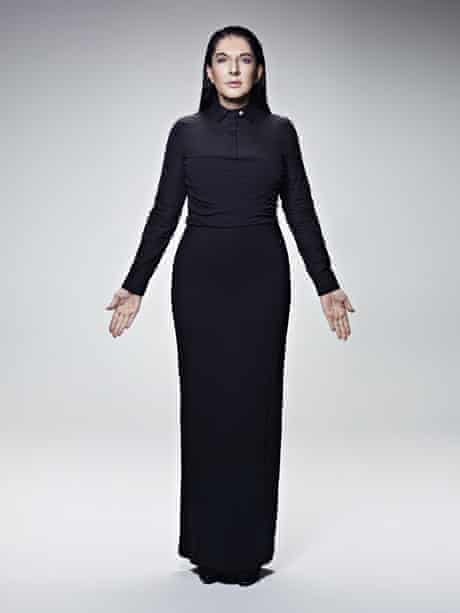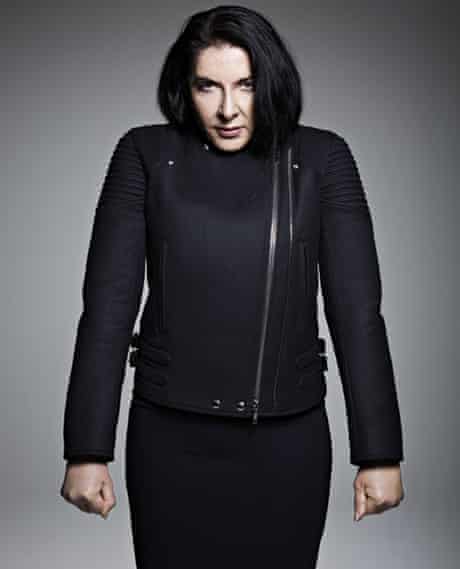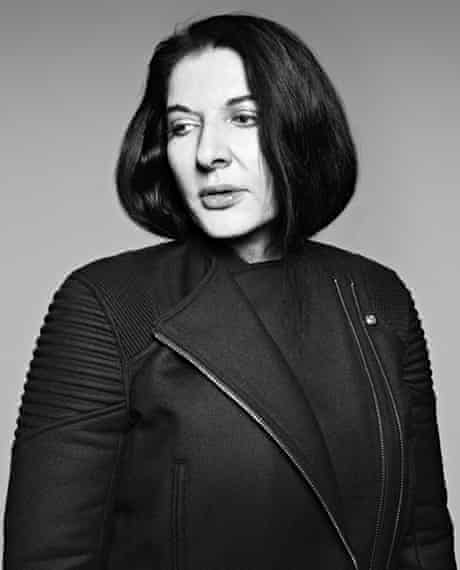Moving Art Piece Chair Coming a Part and Back Together
In 1974, Marina Abramović did a terrifying experiment. At a gallery in her native Belgrade, Serbia, she laid out 72 items on a trestle tabular array and invited the public to apply them on her in whatsoever mode they saw fit. Some of the items were beneficial; a feather boa, some olive oil, roses. Others were non. "I had a pistol with bullets in it, my honey. I was fix to die." At the end of half dozen hours, she walked abroad, dripping with blood and tears, merely alive. "How lucky I am," she says in her notwithstanding heavy accent, and laughs.
This June, Abramović, who at 67 sometimes refers to herself as "the grandmother of performance art", will open an exhibition at the Serpentine Gallery in London, her first original performative evidence in the Uk, in which, she says, she will be more than daring and more vulnerable than she was both in Belgrade and at MoMA in New York, four years ago. Then, Abramović sabbatum in a chair in the gallery for eight hours a solar day, while visitors streamed in and, one by 1, occupied the chair opposite her. Some wept; others laughed. At least one took off all her dress and had to be removed by security. For three months, Abramovic sat in that location, impassive, during which time The Artist is Nowadays drew tape crowds to the gallery and became ane of the most famous and controversial pieces of performance art always staged. Trick News got very cross near what it all meant and referred to her as "some Yugoslavian-born provocateur," while a curator at the Whitney Gallery called her "one of the most significant artists of the second half of the 20th century." For her role, Abramović sat. And sat. And sat.
At present here she is on a tedious morning in a studio in Brooklyn, dressed caput to toe in Givenchy, her favourite designer, and nibbling on what looks similar a pellet of astronaut nutrient. For her Serpentine show, Abramović has to be fit, both mentally and physically. She is on a strict nutrition, and will shortly be leaving for Brazil to meet up with some sort of shamanic adviser. She'll need it; the London show, which is chosen 512 Hours for the duration of time she volition spend in the gallery, volition remove fifty-fifty the few shreds of structure the MoMA evidence clung to. No chair this fourth dimension, and no tabular array. Instead, all day every twenty-four hours from 11 June to 25 August, Abramović will wander effectually the gallery where, after being asked to shed their coats, watches and all their devices, visitors volition exist invited to come in and peer at her. "It'due south the public and me and nothing else," she says. "I took the objects away. But the meet ..." She smiles. "I've never done anything as radical as this. This is equally immaterial equally you tin can go."

When performance art is bad, it is worse than near anything and even the skilful stuff is vulnerable to ridicule. Information technology looks similar nothing on paper; a woman wanders around a gallery – where's the artistry in that? Those tempted to scoff should spotter the HBO documentary on Abramović's MoMA show, to see how an unpromising premise turned, in reality, into an extraordinarily moving serial of encounters. Since her early on days in Serbia, Abramović has put herself under extreme physical and mental duress to jolt viewers out of ordinary patterns of thinking. "The medium is the body," she says, which is what all performance artists say, but when Abramović cuts herself with a knife, or slams her trunk into a wall, information technology is done with such purity of purpose the viewer is lifted temporarily out of themselves. It is the opposite of sensationalism or exhibitionism – a gesture of cocky-erasure in the Romantic sense – and to sit however for three months, inviting connection with strangers is something that, in the context of the harried and distracted lives we live, makes perfect sense. No wonder people cried.
"Yous have to exist in a land in which you lot are completely secure about your ability create this kind of charismatic infinite," she says, and is currently lying awake at nighttime "in total panic" about doing it once more at the Serpentine. "That'south really hell."
It is only recently that whatever of this has hit the mainstream, and Abramović every bit rock star – as well as knocking around with Lady Gaga, who she helped develop strategies to end smoking (such every bit counting grains of rice), she is on the cover of manner magazines and her Maria Callas-esque profile on the fashion to becoming iconic – is the fruit of a 40-yr struggle. For decades, Abramović was poor and across the art world, obscure, living out of a van for the best part of 10 years with her and so life-partner, Uwe Laysiepen, a German artist who performed nether the proper name Ulay and with whom she drove around Europe, collaborating on her seminal work of the 70s. (The van, incidentally, was tracked down and displayed at the MoMA retrospective, which caused Abramović to completely freak out. "That van," she says, and shudders).
When she and Ulay broke up, it was in 1000 style: they turned the death of their relationship into a slice called The Lovers (1988), in which they walked towards each other from ii sides of the Smashing Wall of China – 2,500km each, over the course of several months – meeting in the middle "to say adieu". If that's not devotion to one's art, I don't know what is.
Abramović came out of a tough background. Her parents had close ties to the post-war communist regime of what was then Yugoslavia and her mother raised Abramović in a dwelling house run more like a boot campsite than a family unit. In 2011, she turned what amounted to an calumniating upbringing into a stage production called the Life and Death of Marina Abramović, co-starring Willem Dafoe and Antony Hegarty of Antony and the Johnsons, and in which she played both herself and her mother. "Every rehearsal I cried from the commencement to the stop," she says. "Then one 24-hour interval Bobby [the director] said, enough of this bullshit crying. The public has to cry, non yous. After iii years of touring in Europe, I was free. All these stories don't impact me whatever more. An incredible feeling."
This was after years of critiquing the repressive nature of both her family and her state through performance art. In her piece The Lips of Thomas (1975), she carved a v-pointed communist star into her own abdomen, a monstrously sly up yours to the regime and appropriation of brutality for her ain purposes. In other gallery settings, she and Ulay slammed into each other, shrieked in each other's faces, or sat staring at each other for interminable lengths of time to examination, and conquer, the boundaries of what is endurable. It was thrilling, shocking, above all, moral and sailing always in the face of accusations of meaninglessness. The great danger with this sort of art, of course, is that pain is mistaken for meaning.
"In the beginning there were just masochists doing this shit and it was ridiculous. They needed to go to a psychiatric clinic," she nods. "Information technology's more complicated to explain. In every culture, [there are those] shamans or medicine men who endured incredible concrete pain, because information technology'due south a door opening to the subconsciousness. And the way we can actually control the pain – it'south how to control everything. This is the key."
The feel at MoMA would take turned nigh people mad – sitting still for that length of time, neither speaking nor moving. (There was a curtained pigsty in her chair, with a chamber pot fitted beneath it, so she didn't accept to get up to go to the loo). Abramović was non heedless. The whole point of the do, she says, was to be fully present, concentrating on connecting with whoever came in to sit down opposite her, and "I never saw and so much hurting in my life." The huge number of people who wept, she thinks, was brought on by this staged state of affairs in which "there is nowhere to get except in yourself. Information technology was shocking. But how simple it was."
Before the bear witness opened, both Abramović and MoMA half worried that no 1 would plow upwardly. As the affair took off, celebrities started to drift in to sit down opposite her, including, inevitably, James Franco – and and so Ulay came. Abramović broke protocol and reached out to grasp his hands across the table. Anybody cheered. "I admittedly didn't expect he'd come up to sit. The moment he sabbatum – and everyone got very sentimental about it, because they were projecting their own relationships on to us – but it was then incredibly difficult. It was the only time I broke the rules."
What is her compulsion to move towards, rather than away from the things that most terrify her?

"From a very early time, I understood that I but learn from things I don't like. If yous do things yous like, you only do the same shit. Yous always fall in love with the wrong guy. Because there's no change. It's and so piece of cake to do things you like. But then, the thing is, when yous're afraid of something, face up it, become for it. You get a improve man being."
What'due south the price?
"Ah, a big one. Lots of loneliness, my dear. If you're a woman, it's almost impossible to establish a relationship. Y'all're likewise much for everybody. Information technology'southward besides much. The adult female ever has to play this role of existence delicate and dependent. And if you're non, they're fascinated by y'all, simply only for a little while. So they want to change you and shell y'all. And and then they get out. So, lots of lonely hotel rooms, my dear."
Ulay and Abramović divide up in function because she was moving ahead of him every bit an artist, something he reflects on rather bitterly in the documentary, saying caustically that she became "very ambitious" later on they separated. Abramović has been slammed past some of her peers for making money and dressing in couture, when her whole career has been dedicated to anti-materialism – her least favourite era was the 90s Brit-fine art scene, with its "commodification of art".
She has no time for this. "I've been criticised past my generation, artists from the 70s – and there's nothing more tragic than artists from the 70s still doing art from the 70s – because I mistiness all these borders between way and pop. I really got aroused yesterday, considering at that place was a lady who said 'Marina is not serious because she wants a fashion mag cover.' And because I did an event with Jay Z. She said I'd killed performance art. But who made these rules?"
Anyhow, she says, "I dear fashion. Who says if y'all have red lipstick and nail polish you're not a good creative person."
Her art is still securely anti-materialistic. Information technology is hard to bundle and sell performance fine art, which is why she was drawn to it in the offset place. The nearest y'all can get is video or photographic stills of her at present iconic shows. In 1974, when she invited the public to use those objects on her frozen figure, Abramović exposed a savagery lurking beneath the surface of otherwise civilised human beings. At showtime, visitors to the gallery were hesitant to approach her. Then, in a kind of Lord of the Flies scenario, they started subtly to torture her. "There withal are scars from where the people were cutting me," she says. "They were taking the thorn from the rose and sticking it in my tum. The public tin kill you. This is what I wanted to see."
Just at MoMA, the transactions were loving.
"Yes. I understand that y'all tin bring out the worst in people and the all-time. And I found out how I can turn that into love. My whole idea at MoMA was to give out unconditional honey to every stranger, which I did. And the other one [in Belgrade] was a claiming to every bad energy possible; if you give the guy a concatenation saw ... yous are provoking him."

Incredibly, merely before she started the demonstration at MoMA, she began divorce proceedings from her then-husband, Paolo Canevari, the Italian creative person. "At the end of the project he came back, for a year. Even more terrible. Nothing worked any more. Information technology was – god – endless. But at that place is a part of you lot in these periods that is numb. Y'all are totally blank."
Is she in a human relationship at the moment?
"No. Of course, I dream to accept this perfect man, who does not want to change me. And I'chiliad then non matrimony fabric, it's terrible. But my dream is to take those Lord's day mornings, where yous're eating breakfast and reading newspapers with somebody. I'm so old fashioned in existent life, and I'm and then not former fashioned in art. But I believe in true dear, so perhaps it will happen. Right now, no, I have no space. But life has been good to me. Lots of pain. Just it's OK."
It is an intensely weird way to live and she knows it. How things volition piece of work out at the Serpentine, she doesn't know. British people are so inhibited, she says, and also inclined to ridicule. She is perhaps remembering what happened to David Blaine when he suspended himself in a Perspex box above the Thames all those years ago and was rewarded with jeers and people chucking bottles. Merely Abramović does not belong in his corny showbiz category. In that location is no illusion in what she does; when she cuts herself, it's real. The whole betoken is it'southward real.
Anyway, she says, "working with the British public is particularly hard. They're very sarcastic. They're hands bored. They don't want to be involved in annihilation that might embarrass them, or brand fun of them. And that'due south a huge challenge." She is nervous equally hell.
She is also looking beyond August to September, when she will stage another functioning piece at Sean Kelly Gallery, her professional home in New York and beyond that to her 70th altogether political party, which the Guggenheim has offered to host. "I'm really a warrior of art," she says, the kind of phrase merely a woman with Abramović'due south background can go abroad with. "When I do things I do them properly, and and then the other Marina comes and is very delicate and very vain and wants to swallow ice-cream."
Or to put it another way, she says, "I love bad jokes. I love to savor everything. Then comes this moment to work – and information technology becomes a question of life or death."
Marina Abramović: 512 Hours is at The Serpentine Gallery, London W2, from 11 June to 25 August.
0 Response to "Moving Art Piece Chair Coming a Part and Back Together"
Post a Comment